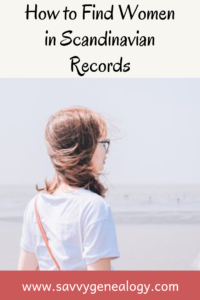How to Find Women in Scandinavian Records
Have you ever struggled with trying to find women’s names in American records because they change their maiden names to their married names in documents? I have also struggled with that in the past. However, it’s not the same case when you’re trying to find Scandinavian women in their records. Once you know the Scandinavian naming pattern, then you can find your women ancestors from birth to death.
Understanding Women’s Naming Patterns
All of the Scandinavian countries rely on the same naming patterns. It’s called the Patronymic System and was used until the early 1900’s. This is a pattern where all of the children were given their father’s first name as their surname with a suffix of “sen” or “datter” at the end. For example, if Peder had a son, then his son’s last name would be Pedersen. If Peder had a daughter, then her last name would be Pedersdatter. The spelling changes somewhat between Denmark, Sweden, and Norway, but that’s basically it. This Family Search Wiki article explains this naming system in more detail.

When the woman married, she would keep her maiden name under this naming pattern. So if Karyn Pedersdatter married Olaf Nilsen, then she would still be Karyn Pedersdatter on all records after her marriage. This is great for you as a genealogist because once you know her birth name, then you can find her as a married woman and all the way to her death. This naming pattern went on well into the 1900’s.
About mid-1900’s things changed. Laws were passed that told people to take a permanent name and keep it for following generations. So people could pick any name they wanted. Most picked their father’s name and instead of saying “sen” or “datter” after their name they would now all be “sen” whether they were boys or girls. They could take place names as their surname such as their farm name or nature names. They could also choose occupation names such as “smith” or “carter” as a permanent name.
When the women married they would take the married name instead of keeping their maiden name. For example, Karyn Pedersen as a child would now be Karyn Nilsen when she married. This pattern is similar to the America naming pattern. However, the new naming system didn’t take hold all at once. Therefore, you will still see the old Patronymic System during the 1900’s as well as people slowly changed their ways. You need to look at the name pattern of your ancestor to see if they changed their name before 1900 or after 1900. If the children all start to use “sen” after their names, then chances are the family has a permanent name.
How to Find Women in Records
Finding records for women who now have a permanent name is very similar to finding American records. You first look for census records. If the mother and the children all have the same name as the father then you now know the permanent name and can search for the woman with that name. If the family all goes by their farm name or an occupation name, then again you have found their permanent name.

Census records usually give birth names and places for each of the family. You can then find the women in church records using their permanent name. Death records will have their permanent names on them as well as probate records. Basically, once you find the woman’s permanent name on census records, then all the other records are opened up to your search.
For more details on how to find these women in other Scandinavian websites then go to these links.
- How to Find Norwegian Birth Records Like a Pro
- Danish Church Records-Is Your Ancestor in There?
- Swedish Church Records
Conclusion
Scandinavian women can either go by their patronymic name or by their permanent name on Scandinavian records. It’s easy to determine which one they preferred by just looking at their last name. If they went by “datter” at the end of their name, then they still used their patronymic name. If they have “sen” or a totally different surname, then they chose a permanent name. This is how you find your women ancestors. After that, it’s just basic genealogy research to find more about them.
In the meantime…good luck and happy hunting!
Tiffany
P.S. Here are some Pinterest links to various Mother’s Day questions that you can ask your female family members to learn more about them. More inspiration is found on Pinterest.
church records, naming patterns, patronymics, scandinavian women, women





